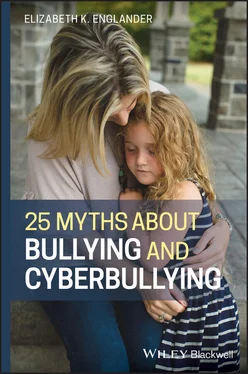3.2 Question #2: When should a parent be most worried about bullying leading to suicidal thoughts or actions?
It's clear that we don't know all the risk factors, but we can pay attention to the ones we do know about. The research suggests that the risk is greatest when the child is already struggling, or begins struggling, with additional emotional difficulties, behavior problems, or any other types of trauma. So a child who has had evidence of conduct disorders, depression, or past suicidality should be assessed if they are also being bullied. They should also be seen if they are struggling with other types of traumas or stressors, such as substance abuse, the death or serious illness of someone significant to them, family changes such as divorce, child abuse, expulsion from school, etc. Some kids are more vulnerable than others: for example, LGBTQ children may be chronic victims of social exclusion and thus might need more attention and care. The bottom line is that parents need to be aware of the signs of depression and look for these in their child. They may want to look especially carefully if they are aware that their child is being bullied or may be particularly vulnerable.
These two questions are the ones I hear the most, but they are not the only questions that remain. For example, perhaps being bullied at one age versus another is more closely linked to suicidality. At this time, researchers usually don't compare different age groups, so no real consensus has emerged, although the risk of suicide in general increases as children begin to go through adolescence. 10 Another pertinent question often arises regarding the psychological impact of cyberbullying. A few studies have found that cyberbullying may be more strongly related to suicidal ideation, relative to traditional bullying 11 , 12 (although, as you'll read in future chapters, separating the two types of bullying today doesn't make much sense). Finally, how can we tell when children and teens are actually depressed? The best method is to regularly see, talk to, and spend time with your child, so you are more apt to notice changes in their mood or behavior. Having said that, there is no absolute, completely reliable indicator – unfortunately. When you're unsure, consult a professional. It's fine to start with your pediatrician or family doctor.
To‐Do for Myth #2: Bullying causes suicide and homicide.
The truth: This relationship is neither simple nor direct.
What if your child isn't the type to talk with you about their social problems or their feelings? You can't force someone to disclose private thoughts to you, and punishing them for not talking will only push them further away. On the other hand, modeling what you're looking for – conversations about social relationships and feelings – can show your child that you're interested in their social lives and how they're feeling. So, take opportunities that come along to begin conversations. When a friend walks by, you could say to your child, “It was nice to see Henry again; are you two still as good friends as you used to be?” Don't be too concerned if all you get is a shrug or a grunt. These kinds of conversations are designed for the long haul; your goal is not just to get information – it's to show genuine interest and to encourage your child to talk when things get tough, because that is a key strategy that helps all of us to cope. After a while, you may begin to hear some real answers to your questions.
Talking to your child – and encouraging them to talk to you – pays off both in terms of the effort and in terms of your ability to detect serious problems when they arise. Many children (especially teenagers) are not inclined to talk with their parents about these issues, but many do ultimately respond when they're gently encouraged to do so. Don't forget, either, that you're not in this alone. Kids can also be encouraged to speak with others, such as their pediatrician, teachers, adult relatives, etc.
When you are talking, listen for changes or indications of depression or hopelessness. If anything alarms or worries you, consult with your pediatrician or family doctor about an assessment and getting help.
1 1Srabstein, J.C. (2013). News reports of bullying‐related fatal and nonfatal injuries in the Americas. Revista Panamericana De Salud Pública = Pan American Journal of Public Health 33 (5): 378–382.
2 2Fein, R., Reddy, M., Borum, R. et al. (2002). The Final Report and Findings of the Safe School Initiative : Implications for the Prevention of School Attacks in the United States. Washington, DC: U.S. Secret Service. https://www2.ed.gov/admins/lead/safety/preventingattacksreport.pdf.
3 3A risk factor is something that increases the risk of disease without necessarily being a direct cause. For example, not wearing a seat belt is a risk factor for being killed in a car crash. The seat belt doesn't cause the crash, but not wearing it is statistically associated with a worse outcome if a crash does happen.
4 4Nordqvist, C. (2013). Strong link between bullying and suicide. Medical News Today (June 19). http://www.medicalnewstoday.com/articles/262150.php.
5 5Ditch the Label. (2018). Annual bullying survey. https://www.ditchthelabel.org/research‐papers/the‐annual‐bullying‐survey‐2018(accessed November 22, 2019).
6 6Klomek, A.B., Sourander, A., and Gould, M. (2010). The association of suicide and bullying in childhood to young adulthood: a review of cross‐sectional and longitudinal research findings. Canadian Journal of Psychiatry. Revue Canadienne De Psychiatrie 55 (5): 282–288.
7 7Bazelon, E. (2010). The untold story of her suicide and the role of the kids who have been criminally charged for it. Slate Magazine (July 21). https://slate.com/human‐interest/2010/07/what‐really‐happened‐to‐phoebe‐prince‐the‐untold‐story‐of‐her‐suicide‐and‐the‐role‐of‐the‐kids‐who‐have‐been‐criminally‐charged‐for‐it‐1.html.
8 8Klomek, A.B., Sourander, A., Niemela, S. et al. (2009). Childhood bullying behaviors as a risk for suicide attempts and completed suicides: a population‐based birth cohort study. Journal of the American Academy of Child & Adolescent Psychiatry 48 (3): 254–261. https://doi.org/10.1097/CHI.0b013e318196b91f.
9 9Kaminski, J.W. and Fang, X. (2009). Victimization by peers and adolescent suicide in three US samples. The Journal of Pediatrics 155 (5): 683–688. https://doi.org/10.1016/j.jpeds.2009.04.061.
10 10Klomek, A.B., Sourander, A., and Gould, M. (2010). The association of suicide and bullying in childhood to young adulthood: a review of cross‐sectional and longitudinal research findings. Canadian Journal of Psychiatry. Revue Canadienne De Psychiatrie 55 (5): 282–288.
11 11van Geel, M., Vedder, P., and Tanilon, J. (2014). Relationship between peer victimization, cyberbullying, and suicide in children and adolescents: a meta‐analysis. JAMA Pediatrics 168 (5): 435–442. https://doi.org/10.1001/jamapediatrics.2013.4143.
12 12Hinduja, S. and Patchin, J.W. (2010). Bullying, cyberbullying, and suicide. Archives of Suicide Research 14 (3): 206–221. https://doi.org/10.1080/13811118.2010.494133.
Конец ознакомительного фрагмента.
Текст предоставлен ООО «ЛитРес».
Прочитайте эту книгу целиком, на ЛитРес.
Безопасно оплатить книгу можно банковской картой Visa, MasterCard, Maestro, со счета мобильного телефона, с платежного терминала, в салоне МТС или Связной, через PayPal, WebMoney, Яндекс.Деньги, QIWI Кошелек, бонусными картами или другим удобным Вам способом.












